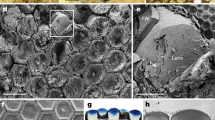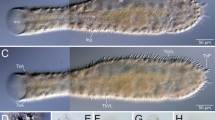Summary
The corneas of some nocturnal Lepidoptera carry an array of surface protuberances (nipples), about 200 mμ high, that acts as an impedance transformer equalizing by gradual transition the refractive index of air to that of the cornea. A screening of the insect class has been carried out in the present study with respect to the variation in corneal topography seen in previous obsarvations.
361 species in most insect orders were prepared for EM by thin sectioning or platinum replication. Using the amplitude of the surface protuberances as parameter, a grouping of the cornea types was made on the basis of the well-defined variation of nipple heights observed between individuals of certain species. Thus, the corneas of one extreme group were either smooth (Fig. 4A) or possessed protrusions (Fig. 4B and C) less than about 50 mμ high, arranged either irregularly or in a regular, hexagonal array (group I). At the other extreme, there was a group with “full-sized” nipples (Figs. 1 and 3) ranging in amplitude around 250 mμ (group III). An intermediate group of nipple heights (group II) comprised corneas with “low-sized” nipples (Fig. 6) between 50 and about 200 mμ high. Regularity in the arrangement of the various types of protuberances was observed both in groups I and II (compare Figs. 4C and 8). Irregularity tended to be associated with low amplitudes (e.g. Fig. 4B), being found only in group I corneas.
Full-sized nipples (group III corneas) were found only among the anagenetically highest orders, Trichoptera and Lepidoptera (Tables 3 and 4), which, however, also had corneas with low protrusions (group I) and low-sized nipples (group II). In one of the two mecopteroid orders, Diptera (Table 2), protrusions and low-sized nipples were found (the latter only in Culicomorpha). The corneas of all other orders (Table 1) had only group I corneas with one noteworthy exception, Thysanura, the most primitive order investigated. All four thysanuran species examined had corneas with low-sized nipples (Fig. 8), thus belonging to group II.
The morphological findings demonstrated in the present study can be taken to illustrate the following trends.
1.a)The higher relative number of group II and III corneas (low- and full-sized nipples) in the anagenetieally highest orders and the exclusive occurrence of group III corneas in the most advanced orders, Trichoptera and Lepidoptera, may indicate a progressive development of nipples during phylogenesis. Thus, the full-sized nipples may represent an apomorphous condition. Parallelisms — leading to the appearance of low- and full-sized nipples — may have occurred several times during insect phylogenetic development, thus possibly reflecting an evolutionary potential (with or without a selective pressure for this character).
b)Low-sized nipples were found in the most primitive insect order, Thysanura. This circumstance may point to regression from full-sized nipples that were present in an ancestor common to all insects. In such a case, the full-sized nipples in Trichoptera and Lepidoptera are to be considered plesiomorphous.
At present nothing supports conclusively a preference for one of these two alternatives.
2.Among the Lepidoptera, a greater relative number of butterflies than moths lack full-sized nipples. This may be taken to indicate a regression of nipples in the day-flying group of insects in comparison with their possible moth-like, nocturnal ancestors. That in many species there are low-sized nipples (the regression thus being incomplete) may indicate that a function of the nipples in ranges of shorter wavelengths has brought about an arrest of the regression at lower amplitudes.
Similar content being viewed by others
References
Bernhard, C. G.: Structural and functional adaptation in a visual system. Endeavour 26, 79–84 (1967).
—, Gemne, G., Møller, A. R.: Modification of specular reflexion and light transmission by biological surface structures. Quart. Rev. Biophys. 1, 89–105 (1968).
- - - Influence on light transmission by variations in insect corneal nipple topography. In preparation (1970).
—, Miller, W. H.: A corneal nipple pattern in insect compound eyes. Acta physiol. scand. 56, 385–386 (1962).
—, Møller, A. R.: Function of the corneal nipples in the compound eyes of insects. Acta physiol. scand. 58, 381–382 (1963).
- - - The insect corneal nipple array. A biological, broad-band impedance transformer that acts as an antireflection coating. Acta physiol. scand. 63, Suppl. 243 (1965).
Brundin, L.: Application of phylogenetic principles in systematics and evolutionary theory. In: Current problems of lower vertebrate phylogeny (IV. Nobel Symposium, Stockholm, June 1967, Ørvig, T., ed.). Stockholm: Almqvist & Wiksell 1968.
Gemne, G.: Ultrastructural ontogenesis of cornea and corneal nipples in the compound eye of insects. Acta physiol. scand. 66, 511–512 (1966a).
—: Fine structure of the insect cornea and corneal nipples during ontogenesis. In: Electron microscopy 1966. Proceedings of the Sixth Internat. Congr. for Electron Microscopy, Kyoto, vol. II, pp. 511–512. Tokyo: Maruzen Co. 1966b.
- Ontogenesis of corneal surface ultrastructure in nocturnal Lepidoptera. In preparation (1970a).
Gemne, G.: Ultrastructure of the developing corneal surface in the honey-bee. In preparation (1970b).
- Ultrastrueture of epicorneal topography and morphogenesis in insects, with aspects on phylogenesis and function. Thesis, in preparation (1970c).
Grassé, P.-P.: Traité de Zoologie, Tome X, fasc. 1. Paris 1951.
Hennig, W.: Grundzüge einer Theorie der phylogenetischen Systematik. Berlin: Deutsch. Zentralverl. 1950.
—: Phylogenetic systematics. Urbana: University of Illinois Press 1966.
- Kritische Bemerkung über den Bau der Flügelwurzel bei den Dipteren und die Frage nach der Monophylie der Nematocera. Stuttg. Beitr. Natk. Nr. 193 (1968).
Locke, M.: The structure and formation of the cuticulin layer in the epicuticle of an insect, Calpodes ethlius (Lepidoptera, Hesperiidae). J. Morph. 118, 461–494 (1966).
Mayr, E.: Animal species and evolution. Cambridge, Mass.: Belknap Press 1963.
Miller, W. H., Bernard, G. D., Allen, J. L.: The optics of insect compound eyes. Microcomponents with dimensions near a wavelength of light cause observable optical effects. Science 162, 760–767 (1968).
—, Møller, A. R., Bernhard, C. G.: The corneal nipple array. In: The functional organization of the compound eye (C. G. Bernhard, ed.) pp. 21–33. London: Pergamon Press 1966.
Perry, M. M.: Further studies on the development of the eye of Drosophila melanogaster. I. The ommatidia. J. Morph. 124, 227–248 (1968).
Ross, H. H.: Evolution and classification of the mountain caddisflies. Urbana: University of Illinois Press 1956.
Taylor, R. L., Richards, A. G.: Integumentary changes during moulting of arthropods with special reference to the subcuticle and ecdysial membrane. J. Morph. 116, 1–21 (1965).
Waddington, C. H., Perry, M. M.: The ultrastructure of the developing eye of Drosophila. Proc. roy. Soc. B 153, 155–178 (1960).
Zeuner, F. E.: Notes on the evolution of the Rhopalocera. Verh. XI. int. Kongr. Ent. Wien 1960, 1, 310–313 (1961).
Author information
Authors and Affiliations
Additional information
This investigation has been sponsored in part by the Air Force Office of Scientific Research through the European Office of Aerospace Research, OAR, United States Air Force, under grants Nos. AF EOAR 66-34 and EOOAR-68-0036, and supported by grants from the Swedish Medical Research Council and Stifteisen Gustaf och Tyra Svenssons Minne.
We are grateful to Prof. L. Brundin, Department of Entomology, Swedish Museum of Natural History, Stockholm, for valuable discussion concerning the phylogenetic aspects.
We also thank the William Beebe Tropical Research Station (New York Zoological Society), Arima Valley, Trinidad, West Indies.
Rights and permissions
About this article
Cite this article
Bernhard, C.G., Gemne, G. & Sällström, J. Comparative ultrastructure of corneal surface topography in insects with aspects on phylogenesis and function. Z. Vergl. Physiol. 67, 1–25 (1970). https://doi.org/10.1007/BF00298117
Received:
Issue Date:
DOI: https://doi.org/10.1007/BF00298117




